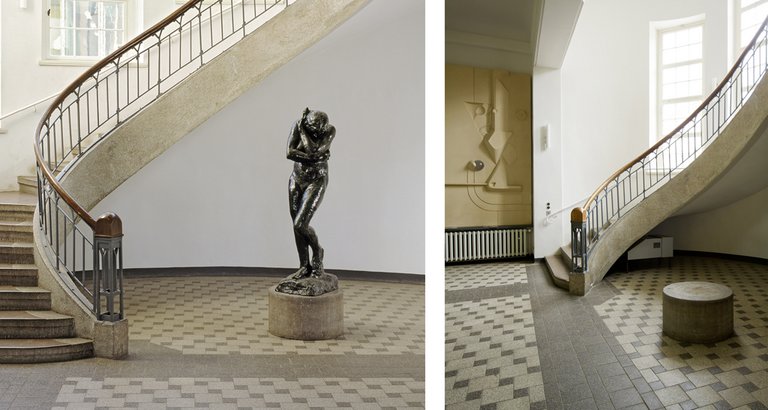»Eva« was immediately handed over to experts on Monday 8 February 2016. She had visible damage on her shoulders, arms and pedestal, which received a direct hit. A thorough examination by various specialists will be undertaken in order to ascertain the extent of the damage to the bronze casting and identify any cracks to the body of the statue.
It is not yet clear how long the restoration will take or how much it will cost. Experts are expecting it to be months until the statue can be returned to the main building. Over the coming days, a banner depicting »Eva« will be hung in the foyer to fill the gap left by this act of violence.
»Eva« has adorned the halls of the Bauhaus-Universität Weimar unscathed for over 103 years, most of which have been spent in its current position in the foyer of the main building. Fritz Mackensen, the former director of the Weimar Saxon Grand Ducal Art School, acquired it from the Parisian sculptor Auguste Rodin’s own workshop in 1911. He was able to persuade Rodin to make another bronze cast for Weimar, and a donation from a manufacturer in Apolda enabled this figure (at the time not uncontroversial in Weimar) to be brought home.
Mackensen placed it in a central location in the school of art – a unique position for modern European and international art. It was moved to the entrance hall in December 1912. Ever since, »Eva« has offered up an impressive interplay of shape and light with the stairwell of the main building, designed by Henry van de Velde and inaugurated in 1911. As well as making this a destination of choice for many tourists, it has also served as a point of reference for the building’s users over the decades.
Many people have stories of »Eva« as the central focus of sparkling celebrations, decorated and lovingly framed by work from the introductory course, but according to head of the modern archive Dr. Christiane Wolf it was rarely at severe risk – she was always afforded respect and distance, including when she was temporarily moved to Humanitas in Berlin (created by Hans van Breek) for the “World Festival of Youth and Students”.
Even in 1916 she escaped damage or even being melted down, as the very same Fritz Mackensen who had collected »Eva« from Paris cleared her from the foyer as an example of the enemy’s art. It is unclear exactly where she was stored during this period and when she was returned to her pedestal, as there is no account of her locations. “Eva” and the other works of art around the main building and Van de Velde structure tell the University’s story and bring it to life, contributing to the building complex being named a UNESCO World Heritage Site.
The Bauhaus-Universität Weimar is deeply shocked and saddened by this act of violence against its most important work of art at one of the most prominent and popular locations on campus.
Further information:
The incident will be covered live by MDR television on Sunday 21 February 2016 during the programme Kripo live. If you have the opportunity, please watch the programme and contact the Weimar police department if you are able to offer any information. Recordings from surveillance cameras will be shown.
Kripo live (MDR TV)
Sunday 21 February 2016
7:50 p.m.
Programme repeated:
Monday 22 February 2016
9:45 a.m.
Contact:
Volker Schönbrunn
PI Weimar, AG Graffiti
Tel: 036 43/ 882 - 118
Email: volker.schoenbrunn[at]polizei.thueringen.de
